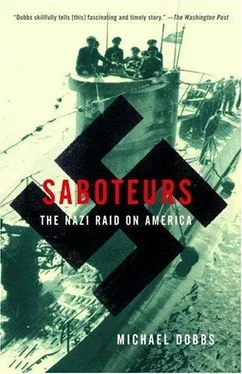THE MOST obvious flaw in Operation Pastorius was the lack of ideological commitment and cohesion among its principal protagonists. Although most of the saboteurs either were Nazi Party members or had Nazi connections, they lacked the ideological zeal to sacrifice themselves for the cause. The only one among them who believed in the mission wholeheartedly was Kerling, the leader of the Florida group, and even he had personal reasons for coming to America. To varying degrees, the saboteurs were all seduced by American plenty, which contrasted so starkly with the poverty of wartime Germany. “In Germany, you couldn’t buy a pair of shoes, a piece of meat,” recalled Haupt’s friend Wolfgang Wergin, who was offered a place on the sabotage team by Kappe, but declined. “Everything was rationed. Nobody in his right mind was going to go from a country like that to a country with everything, like America, and start blowing things up. You’d have to be nuts.” 34
Six decades later, of course, a group of Islamic terrorists would do precisely that, and plot the destruction of the World Trade Center at the very time they were leading the life of American suburbanites, ordering pizzas, visiting shopping malls, and dropping into video stores. The Nazi saboteurs were as well trained and just as well funded as the September 11 hijackers. They had the logistical support of the German armed forces. So why did one plot succeed and the other fail? One reason is that Osama bin Laden’s brand of militant Islamic fundamentalism is more myth than reality. Until the bin Laden myth is discredited in practice, it will remain a rallying point for the resentful and the deprived. By contrast, by 1942 the Third Reich was not just a myth; it was a very grim reality, and a much less attractive one than the reality of wartime New York and Chicago.
Even so, Operation Pastorius was hardly doomed to fail. A wartime study by the Office of Naval Intelligence concluded that Kerling, supported by others like him, might well have succeeded in carrying out its mission. 35America’s coasts were poorly defended against saboteurs. The freedom with which Haupt moved around Chicago, and the fact that none of his friends or relatives gave him away, suggested there was a sizable German-American population willing to offer shelter to Nazi agents.
There is a fine line between success and failure when it comes to sabotage operations. The difference between a triumph and a fiasco can often boil down to one false move or unfortunate coincidence. In different circumstances—with better luck, better planning, and, above all, better leadership—Hitler might have pulled off his gamble, and brought a war that had already engulfed much of the rest of the world onto American soil.
ADMIRAL WILHELM CANARIS, the Abwehr chief who signed the order for Operation Pastorius, was executed by the Nazis in the courtyard of the Flossenberg concentration camp on April 9, 1945, along with four other prominent opponents of Hitler. He was strung up naked on a hastily erected gallows, and his body was then cut down and left to rot.
General Erwin von Lahousen, the head of the sabotage division of the Abwehr, who supervised Operation Pastorius, appeared as a witness for the prosecution in the Nuremberg trials of Nazi war criminals. After two years in Allied military prisons, he returned to his native Austria, where he died in 1955.
Walter Kappe became a trade union official in Hanover. As he got older, he drank ever more heavily, and took a succession of increasingly minor union jobs. He ended up running a souvenir shop outside a U.S. Army base in Frankfurt, and died in 1958. 36
Peter Burger lost his job as manager of a U.S. Army motor pool in Würzburg in 1951 following an Associated Press article that drew attention to his past. He kept in touch with the FBI for many years, submitting regular reports on the activities of his former companions and sending Christmas cards to J. Edgar Hoover. The last mention of him in FBI records is in 1961, when he was reported to be employed by the Bayer pharmaceutical company in Cologne and in good health after recovering from a heart attack. 37
George Dasch failed in his repeated attempts to get back into the United States, largely because of Hoover’s vehement opposition. “This is outrageous,” the FBI director scrawled on a March 1958 State Department memorandum recommending a visa for Dasch. “Make as strong a case against Dasch as possible.” 38Dasch published his account of Operation Pastorius in 1959 under the title Eight Spies Against America. It received little attention. He died in Germany in 1992.
I first became interested in the case of George Dasch and the Nazi saboteurs after stumbling across a treasure trove of research material at the National Archives in College Park, Maryland. The FBI records of the Dasch case include forty boxes of original material, each containing thousands of pages of memoranda, photographs, letters, interrogation reports, newspaper clippings, and other memorabilia. Since this was one of the FBI’s most important cases, anything of relevance to the investigation was preserved, including the handkerchiefs with secret writing that Dasch and Kerling used to list each other’s contacts and letters written by the saboteurs to their families on the day of their execution. The records are a researcher’s dream.
Unless otherwise stated, the notes below refer to the FBI records at NARA, which can be found in Record Group 65, FBI Headquarters Files. The main file number for the Dasch case is 98-10288. When available, I have provided the subfile number, e.g., 98-10288-3472. (In this example, 98 is the FBI headquarters reference number for all sabotage cases, 10288 is the Dasch case, and 3472 is a report on the postwar interrogation of Wilhelm Ahlrichs, a German Naval Intelligence officer.)
While the FBI records contain the most exhaustive information on the Nazi saboteur case, many other agencies kept records on the case, including the Department of Justice, the Coast Guard, the Office of the Secretary of War, the U.S. Army and Navy, and the Secret Service. The Franklin D. Roosevelt Library at Hyde Park has its own saboteur collection. Transcripts of the military commission can be found in several places, including the FDR Library, the Records of the Army Staff (RG 319), and the Records of the Judge Advocate General (RG 153). I have used the following abbreviations in the source notes:
AP Associated Press
BdU Befehlshaber der Unterseeboote, Commander in Chief of U-boats
ESF Eastern Sea Frontier
FBI Federal Bureau of Investigation
FDR Franklin Delano Roosevelt
NARA National Archives and Records Administration
NYT New York Times
ONI Office of Naval Intelligence
OWI Office of War Information
PRO Public Record Office, London
RG Record Group
WP Washington Post
1. Lahousen/Abwehr diary for April 16, 1942, NARA, RG 238, Reference Files 1933-1946 (Entry 2), Box 18.
2. Roger Manvell and Heinrich Frankel, The July Plot, 102. For description of the Wolf’s Lair, see also Constantine FitzGibbon, 20 July, 10–17.
3. Max Seydewitz, Civil Life in Wartime Germany, 100–101.
4. FDR radio address, December 29, 1940; see also State of the Union address, January 1, 1942.
5. H. R. Trevor-Roper, Hitler’s Table Talk, 1941–44, 180.
6. Ibid., 188.
7. Ibid., 179, 545.
8. Ibid., 279.
9. Don Whitehead, The FBI Story, 199.
10. Karl Heinz Abshagen, Canaris, 183–190, Charles Wighton and Günter Peis, Hitler’s Spies and Saboteurs, 42–48, and Erwin Lahousen interview with AP reporter George Tucker, December 6, 1945, NARA, reprinted in part in NYT, December 10, 1945. The Wighton and Peis book must be treated with caution as it includes clearly fabricated dialogue, even though it is based on interviews with Lahousen and extracts from the Abwehr war diary.
Читать дальше












